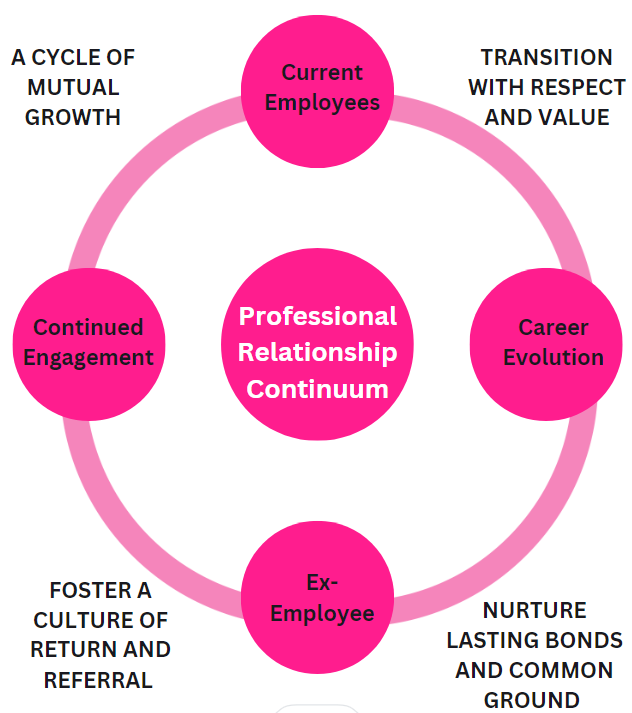August 21st, 2024

—-
I had an ex-business owner say to me recently “Why would you stay in contact with past staff anyway?” In answer to that I’d like to introduce you to Talita…
Talita used to work for me. Talita resigned under bittersweet circumstances. There were tears and fears. However, I recently went to Talita’s 30th birthday celebration. Yes! I still got an invite! Guess what? Talita is much happier not working for me. And she is excelling at her new job too.

Why am I still in contact with Talita? I like her. We may not have been a match in what I could offer her for her career, but that doesn’t mean we can’t catch up for coffee and parties and give each other our most recent updates!
I have always had an open-door policy with people I have worked with in the past, whether they are employees, contractors, or colleagues. Whether I like them a lot or not.
Why? It’s a network. It’s a network of people you know, and they know other people as well!
On the opposite spectrum, I recently heard of an employee being made redundant, and she decided to message her employer and let her know that all of her work-from-home equipment was ready to be picked up ….. from the front footpath!!! Now, how is this behavior going to keep doors open for her in the industry she works in?
Sometimes it’s easy to forget that behind every role, title, and desk is a human being with dreams, aspirations, and emotions. My experience with Talita and contrasting it with the story of the employee leaving her equipment on the footpath reinforces a belief I’ve held throughout my career.
⭐ Maintaining positive relationships, even after paths go in different directions.
⭐ It’s not just a courtesy, it’s a vital part of a thriving professional life.
The connections we make, the respect we give, and the networks we build – these are the real assets we accumulate over our careers. They go much further than the immediate gains of any job or project. So, whether it’s a coffee catch-up or a birthday party invite, cherish these moments. They are opportunities to strengthen bonds and open doors to future possibilities we might not yet imagine.

From Lost to Found: The Continuity of Connection
A few years back, my son, Isaac, was working in the yard of a house we were getting ready to sell. We had already moved out and were just cleaning up the place. At the end of the day, my son realised the ring he wore from my dad (his Opa), who had passed away, was missing from his finger.
He was very upset about it. That ring meant the world to him; it was his connection to his Opa. We all looked everywhere for it – in the yard, in the bins – but no luck. My son kept saying how much he missed the ring and wished he’d been more careful and worn gloves.
Then, two years on, my husband was clearing out his toolbox and dumped everything out on the floor. He spotted something small and shiny at the bottom of the bag – it was the ring! He took a picture and sent it to Isaac, and we all couldn’t stop laughing and feeling relieved and happy. It was like Opa was still around, playing his jokes on us. Isaac wears the ring now, and it’s even more special to him after all that happened.
Just like the unexpected return of the ring, maintaining connections with people from our past can sometimes bring back something precious into our lives. It’s a reminder that the value of relationships, much like the ring, often goes beyond what we initially see, enriching our professional and personal journeys in ways that we are initially unaware of.
In the Harvard Business Review (HBR) article Love Your Ex-Employees and They’ll Love You Back, it talks about how important it is to keep a good relationship with people who used to work for us. The main point is, that if we treat our former employees well, they can actually help us out in the long run.
They can spread the word about how great our company is, which can bring in new customers or even help us find new talent. It’s like they are still part of the team, even if they don’t work with us anymore. It’s pretty clear that keeping in touch and staying on good terms with people who used to work for us is a smart move. It’s not just about being nice; it’s good for business too. Let’s keep building those relationships because they really matter.
Professional Relationship Continuum: Cycle of Mutual Growth
It’s clear that keeping in touch with the people who used to be on our team is more than just a nice thing to do—it’s smart business. The model for the Cycle of Mutual Growth shows exactly that. It’s all about keeping the good stuff going round: from the people we work with every day, to those moving on to new things, and even to the ones who’ve moved on but still pop back to say hi or help out. It’s a circle that keeps on giving.

Current Employees:
This is the team we’re working with right now. They’re the front line of our business, bringing in fresh ideas and driving our current projects. We invest in them, help them grow, and they, in turn, push our business forward. It’s a mutual growth process where we all benefit from the daily grind.
Career Evolution (Transition with Respect & Value):
Careers are always in motion, and sometimes that means our team members will move on. It’s a natural part of the professional journey. When they do, we make sure to honor their contributions and support their next steps.
This transition, handled with respect, paves the way for the next phase – both for them and for us. It shows our current team that we value long-term growth, even when it leads outside our doors. This care in transition ensures a positive evolution for all involved, reinforcing the strength of our professional ecosystem.
Ex-Employee (Nurture Lasting Bonds and Common Ground):
When team members transition to ex-employees, they don’t become distant memories. Instead, they become part of our extended professional family. By nurturing lasting bonds and finding common ground, we maintain a relationship that extends beyond the confines of daily work.
These former employees carry with them the legacy of our company’s culture and values, and through maintaining a strong connection, they often become ambassadors for our brand. Whether it’s through industry chatter or personal recommendation, they help extend our reach. This nurturing not only keeps our network vibrant but also reaffirms to current employees that their value to us transcends their immediate role or tenure at the company.
Continued Engagement (Foster a Culture of Return & Referral):
This final piece of our model celebrates the ongoing collaboration with our ex-employees. We’re not just waving goodbye at the exit door; we’re inviting them to stay in the loop, contribute and share opportunities that can help us grow. By fostering a culture where former team members feel welcome to return, whether for collaborative projects, mentorship, or even re-employment, we’re tapping into a wealth of resources.
They might refer top candidates our way or come back with new skills and experiences that enrich our team. This continued engagement closes the loop, feeding back into the cycle of mutual growth. It shows the current squad that there’s a lasting relationship to be had here, one that can continue to provide value in various forms throughout their careers.
Your Next Steps to Success
- Establish an Alumni Network: Keep former employees in the loop with a dedicated platform or events. This network will not only keep the connection alive but also foster a community that can contribute to future company growth.
- Encourage and Support Career Development: Show that your investment in employees is for the long haul by offering support even after they’ve moved on. Whether it’s through mentorship or professional resources, make it clear that their success is still important to you.
- Foster Open Communication: Maintain regular contact with former employees. This could be through updates, feedback sessions, or casual check-ins. It keeps the relationship strong and can lead to potential re-hires or referrals.
- Collaborate with an Expert: For personalised guidance on nurturing these vital relationships, consider partnering with an expert. Explore how we can work together to build a strong network of lasting professional connections that support your business’s growth and resilience.


View comments
+ Leave a comment